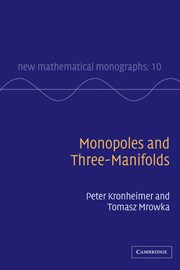Book contents
- Frontmatter
- Contents
- Preface
- I Outlines
- II The Seiberg–Witten equations and compactness
- III Hilbert manifolds and perturbations
- IV Moduli spaces and transversality
- V Compactness and gluing
- VI Floer homology
- VII Cobordisms and invariance
- VIII Non-exact perturbations
- IX Calculations
- X Further developments
- References
- Glossary of notation
- Index
V - Compactness and gluing
Published online by Cambridge University Press: 19 September 2009
- Frontmatter
- Contents
- Preface
- I Outlines
- II The Seiberg–Witten equations and compactness
- III Hilbert manifolds and perturbations
- IV Moduli spaces and transversality
- V Compactness and gluing
- VI Floer homology
- VII Cobordisms and invariance
- VIII Non-exact perturbations
- IX Calculations
- X Further developments
- References
- Glossary of notation
- Index
Summary
In our discussion of finite-dimensional Morse theory in Chapter I, we touched on the important fact that the space of flow lines between two critical points, a and b, of a Morse function is in general not compact. There is an obvious source of non-compactness arising from the fact that a trajectory γ(t) can be reparametrized as γ(t + t0); but there is an additional source of non-compactness, wherein a sequence of trajectories can converge to a “broken trajectory”: a concatenation of trajectories between intermediate critical points. The space of trajectories (modulo reparametrization) can be compactified by adding such broken trajectories. Section 16 establishes essentially the same result in the context of the infinite-dimensional Morse theory of the Chern–Simons–Dirac functional. These compactness theorems for global trajectories leverage our earlier compactness results for solutions on finite cylinders, from Chapters II and III.
The remaining sections of this chapter are concerned with gluing. The question here is to understand the structure of the compactification of the trajectory space near the broken trajectories. The term “gluing” arises because we are investigating whether, for example, the existence of a pair of trajectories with a common endpoint implies the existence of a continuous unbroken trajectory nearby.
- Type
- Chapter
- Information
- Monopoles and Three-Manifolds , pp. 274 - 374Publisher: Cambridge University PressPrint publication year: 2007



